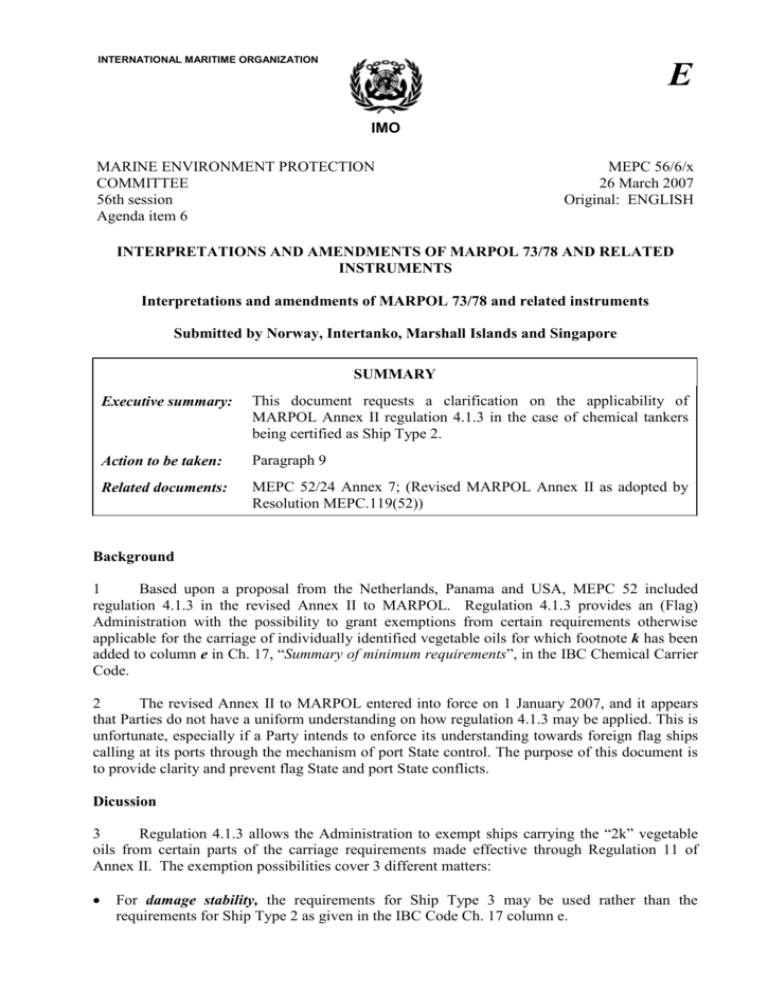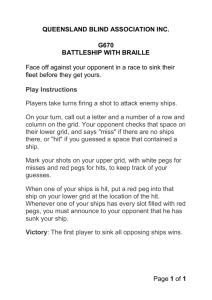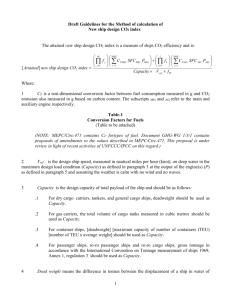here - Intertanko
advertisement

INTERNATIONAL MARITIME ORGANIZATION E IMO MARINE ENVIRONMENT PROTECTION COMMITTEE 56th session Agenda item 6 MEPC 56/6/x 26 March 2007 Original: ENGLISH INTERPRETATIONS AND AMENDMENTS OF MARPOL 73/78 AND RELATED INSTRUMENTS Interpretations and amendments of MARPOL 73/78 and related instruments Submitted by Norway, Intertanko, Marshall Islands and Singapore SUMMARY Executive summary: This document requests a clarification on the applicability of MARPOL Annex II regulation 4.1.3 in the case of chemical tankers being certified as Ship Type 2. Action to be taken: Paragraph 9 Related documents: MEPC 52/24 Annex 7; (Revised MARPOL Annex II as adopted by Resolution MEPC.119(52)) Background 1 Based upon a proposal from the Netherlands, Panama and USA, MEPC 52 included regulation 4.1.3 in the revised Annex II to MARPOL. Regulation 4.1.3 provides an (Flag) Administration with the possibility to grant exemptions from certain requirements otherwise applicable for the carriage of individually identified vegetable oils for which footnote k has been added to column e in Ch. 17, “Summary of minimum requirements”, in the IBC Chemical Carrier Code. 2 The revised Annex II to MARPOL entered into force on 1 January 2007, and it appears that Parties do not have a uniform understanding on how regulation 4.1.3 may be applied. This is unfortunate, especially if a Party intends to enforce its understanding towards foreign flag ships calling at its ports through the mechanism of port State control. The purpose of this document is to provide clarity and prevent flag State and port State conflicts. Dicussion 3 Regulation 4.1.3 allows the Administration to exempt ships carrying the “2k” vegetable oils from certain parts of the carriage requirements made effective through Regulation 11 of Annex II. The exemption possibilities cover 3 different matters: For damage stability, the requirements for Ship Type 3 may be used rather than the requirements for Ship Type 2 as given in the IBC Code Ch. 17 column e. Page 2 For cargo tank loction, the requirements of 4.1.3.2 replace the Ship Type 2 tank location requirements of the IBC Code item 2.6.1.2 (or the BCH Code item 2.2.4 (b) (iii)). For maximum permissible quantity of cargo in each cargo tank, the 3000 m3 restriction of the IBC Code item 16.1.2 is lifted by 4.1.3.1, which introduces the Ship Type 3 requirements. 4 It is the view of co-sponsors that regulation 4.1.3 does not exclusively adress Ship Type 3 tankers. Item 4.1.3.1 says: the ... tanker shall meet all requirements for ship type 3 as identified in the IBC Code..... . A ship being certified as a Ship Type 2 does undoubtedly "meet all requirements for ship type 3". This is obvious from the fact that a Ship Type 2 may be "downgraded" at any time to Ship Type 3 simply by re-issuing the Certificate of Fitness and removing the ST2 products from the List of Products allowed to be carried. Consequently, we are of the opinion that the exemption clause 4.1.3 may be used irrespective of the Ship Type given on the ship’s Chemical Carrier Code Certificate of Fitness. When the exemption is authorized for a ship holding a Ship Type 2 certificate, the only exempted requirement would be for the maximum permissible quantity. 5 Apart from a strictly formal reading of the text, we would also emphasise that the requirements of Annex II should be applied in a reasonable and logical way. It can never be reasonable to treat a better ship more strictly than a ship of a lower standard. 6 Norway Intertanko, Marshall Islands and Singapore wish to point out that a large number of chemical tankers is affected by this controversy. These ships come at least from the following groups: Older chemical tankers built with double bottom, single sides and 2 longitudinal bulkheads. When certified as Ship Type 2 tankers the centre tanks on these ships are acceptable for Ship Type 2 and Ship Type 3 products while the side tanks (with single skin) are acceptable only for Ship Type 3 products. Only the centre tanks are used for the carriage of Type 2(k) products. In many cases these centre tanks each have a capacity exceeding 3000 m3. Some older tonnage has already been converted to double sides and do thereby comply fully with ST2 requirements for both the original centre tanks and the converted side tanks. Centre tanks are frequently in excess of 3000 m3 and may therefore not be fully utilised unless the EXEMPTION CLAUSE is accepted also for ST2. Newer combined oil product / chemical tankers built with full double hull and typically 6 or 7 pairs of cargo tanks (plus 1 pair of slop tanks). Typical tank sizes for these ships are 3 500 to 5 000 m3. In most cases these ships will comply with Ship Type 2 damage stability requirements (if necessary after some additional calculations). It seems clear that the number of ships being affected has not been taken into account at the early stages of these considerations. 7 On the basis of an apparent difference in the understanding of the application of regulation 4.1.3 among Parties, and signals causing fear for detentions, a number of Owners of such ships have already asked for a downgrading of their ships to Ship Type 3. The reason for this is to be able to maximize the carrying capacity of vegetable oils in their ships in a safe and efficient manner. This has and is continuing to cause considerable confusion at the most hectic period of implementing the revised Annex II. Further, the Owners might find themselves in a situation where the certificate is being changed frequently between ST2 and ST3 (with the ST3 certificate being used on voyages when the ship has no ST2 cargoes onboard). The complexity Page 3 and number of people involved in the voyage planning for each ship will undoubtedly cause situations to occur where ST2 cargoes may inadvertently be onboard at a time when the ship is operating on its ST3 certificate, and visa-versa This type of frequent change in certification is deemed to be both unfavourable and unnecessary, should be avoided and should not be required. 8 We are further of the view that applying 4.1.3 differently between ST2 and ST3 ships regarding the issue of maximum permissible quantity of cargo in each tank (ref. IBC Code item 16.1.2) does not necessarily provide for more environmental protection. On the contrary, the environmental effects could prove to be negative for the following reasons: In cases where a ST2 ship is used with partial filling, this may result in a greater number of cargo tanks being utilised which again would result in more cargo tanks having to be cleaned creating more residues / tank cleaning water to be generated for discharge into the sea and to reception facilities of questionable availability In cases where a ST2 or 3 is used with partial filling, with footnote k vegetable oils then residues remaining after stripping will increase by virtue of cargo sloshing en-route, (as the cargoes are heated this would result in “cold” clingage on the upper cargo tank bulkheads). In cases where a ST2 ship is downgraded to ST3 for a specific voyage, this would have no added environmental benefits other than to reduce the number of tanks needed and would instead cause nothing but additional paper work and confusion. In cases where the carriage of vegetable oils is shifted from ships able to comply with ST2 requirements to ships meeting only ST3 requirements (and accepted for vegetable oil carriage based on 4.1.3), then the carriage has been transferred to ships of a lower standard. Action requested of the Committee 9 The Committee is requested to confirm that granting exemptions in accordance with regulation 4.1.3 to a chemical tanker certified as a Ship Type 2 is not a violation of MARPOL Annex II. ***




